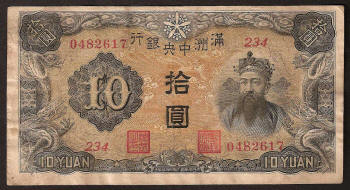 |
|||||
|
|
About Manchukuo The name Manchukuo has been used throughout the website but this is just one of many spellings used. Elsewhere, you will find references to Manchuokuo (Manchu State), Manzhouguo, Manshūkoku, Manchoutikuo (Manchu Imperial State), etc., they all refer to the Manchurian region of North Eastern China ruled by the Japanese puppet government of H. I. H. Henry Pu-Yi, subsequently Emperor Kang-teh, between 1932 and 1945. In the West the "correct" name to use is probably Manchuokuo but common usage dictates the use of Manchukuo. This being a website that I hope people will visit I am bound to go with the majority for practical reasons, not least the use of Search Engines such as Google. In September of 1931 the Japanese had a small army in Manchuria in the form of the Railway Guard, (the Kwantung), ostensibly to protect Japan's railway interests in the region. An excuse was devised in the form of the Mukden Incident for the Japanese to occupy Manchuria. The fact that the small Japanese army of only 11,000 men was able to defeat the Chinese North Eastern army of 250,000 gives you a good idea of how chaotic the Chinese organisation was in the region. In the Northern part of Manchukuo and particularly in Harbin there were large populations of "White" Russians. While the towns were reasonably safe, the countryside was considered dangerous due to the large number of bandit gangs at large. Most towns had walls to keep out undesirables and gates that closed at dusk, travel was risky without armed guards. Corruption was rife, the local currency unstable, transport unreliable and for the local population times were hard. On the 1st March 1932 Manchukuo came into existence with Henry Pu-Yi as Chief Executive. In 1933 the province of Jehol surrendered to the Japanese with only a token resistance and became part of Manchukuo and on 1st March 1934 Henry Pu-Yi became Emperor Kang-Teh. (Pronounced "Con Der" by speakers of Mandarin). The Japanese managed to re-organise Manchukuo, providing a stable currency, eliminating much of the corruption, developing infra-structure, industry and transport systems; rebuilding cities and transforming medicine, law, policing and the judiciary. Despite these improvements they were disliked by most of the populace because of the harsh way in which they achieved this, and because they made the population of Manchukuo second class citizens in their own country. Koreans being paid 50% more for similar jobs of work, while the Japanese were paid double. For a full history of this short lived nation simply enter "Manchukuo" into Google or any similar search engine. There is also interesting original Newsreel footage on Youtube if you care to look. Many of the events in the history of Manchukuo are recorded in the stamps that were issued during the puppet states short existence. The final stamp issued in 1945 was only in use for three months before the Russian "August Storm" offensive swept through Manchukuo consigning the short lived empire to the history books. At the end of the war there were 1000's of sheets of stamps in stock and those not subject to Manchurian Local Overprints (MLO's) quickly found their way to the philatelic market. This is the reason why the unused stamps of Manchukuo are mostly inexpensive, and why stamps cancelled, or on covers as a result of genuine postal use are often considered more valuable. Few countries recognised Manchukuo and it never became part of the Universal Postal Union, fortunately most nations, did deliver the mail from Manchukuo. (One of the few to recognise Manchukuo as a sovereign state was the Vatican, and anyone who looks closely at covers from this area will see that a large number are from Catholic missions). In an act of true independence for Manchukuo rejected the stamp colour regimes of both the Universal Postal Union and Japan. To help you appreciate the availability of these stamps the number of stamps of each value thought to have been printed (where these are known) is shown beneath each image. The number of stamps printed varies between sources. In this instance the numbers are taken from the work of Helen K Zirkle as published in her book "The Postage Stamps and Commemorative Cancellations of Manchoukuo" (published in 1964 - now out of print). The population of Manchukuo in 1932 was in the region of 35,000,000 and by the time of the first census in 1940 this had risen to over 43,000,000. The currency was based
upon that of Japan, in Japan 100 Sen = 1 Yen, in Manchukuo 100 Fen =
1 Yuan. This replaced the Chinese Silver Dollar, in use in Manchuria
prior to the formation of Manchukuo. Above - a well used 1937 Central Bank of Manchukuo 10 Yuan Banknote, it features Emperor Ch'ien-lung Ti the fourth Qing Emperor of China and the fifth of the Manchu dynasty.
|
||||

